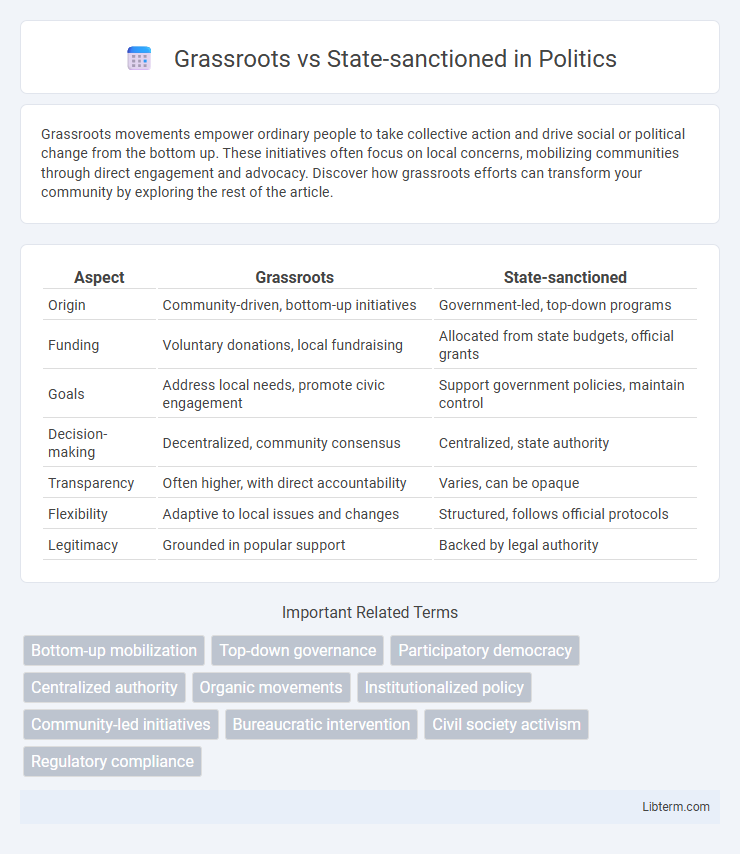Grassroots movements empower ordinary people to take collective action and drive social or political change from the bottom up. These initiatives often focus on local concerns, mobilizing communities through direct engagement and advocacy. Discover how grassroots efforts can transform your community by exploring the rest of the article.
Table of Comparison
| Aspect | Grassroots | State-sanctioned |
|---|---|---|
| Origin | Community-driven, bottom-up initiatives | Government-led, top-down programs |
| Funding | Voluntary donations, local fundraising | Allocated from state budgets, official grants |
| Goals | Address local needs, promote civic engagement | Support government policies, maintain control |
| Decision-making | Decentralized, community consensus | Centralized, state authority |
| Transparency | Often higher, with direct accountability | Varies, can be opaque |
| Flexibility | Adaptive to local issues and changes | Structured, follows official protocols |
| Legitimacy | Grounded in popular support | Backed by legal authority |
Understanding Grassroots Movements
Grassroots movements originate from local communities and rely on direct participation of ordinary individuals to advocate for social or political change, emphasizing bottom-up mobilization. These movements often contrast with state-sanctioned initiatives, which are officially supported or implemented by governmental institutions and may lack the organic engagement found in grassroots efforts. Understanding grassroots movements involves recognizing their power to influence policy and public opinion through collective action driven by shared values and local needs.
Defining State-Sanctioned Initiatives
State-sanctioned initiatives refer to programs or actions officially approved and funded by government authorities to address social, economic, or environmental issues within a jurisdiction. These initiatives often involve regulatory frameworks, formal oversight, and substantial resource allocation to ensure implementation aligns with public policy objectives. Their legitimacy stems from legal authorization, contrasting with grassroots efforts that emerge organically from community participation without formal government endorsement.
Origins and Motivations: Grassroots vs State-Sanctioned
Grassroots movements originate organically from the community, driven by local needs, shared values, and collective goals, often emerging as a response to perceived social or political injustices. State-sanctioned initiatives, by contrast, are government-endorsed actions designed to implement official policies, maintain order, or advance national interests, reflecting top-down authority and institutional agendas. Motivations behind grassroots efforts emphasize empowerment and social change from below, while state-sanctioned activities focus on control, stability, and state-defined progress.
Organizational Structures and Leadership
Grassroots movements typically feature decentralized organizational structures that emphasize community participation and collective leadership, fostering flexibility and local engagement. State-sanctioned organizations often employ hierarchical leadership models with formalized roles and top-down decision-making processes to ensure alignment with government policies. These contrasting frameworks influence the effectiveness, accountability, and responsiveness of each type of movement in addressing social and political issues.
Funding Sources and Resource Allocation
Grassroots movements typically rely on small-scale donations, volunteer efforts, and local fundraising events, leading to decentralized funding sources and community-driven resource allocation. In contrast, state-sanctioned initiatives benefit from government budgets, grants, and official funding channels, which enable large-scale resource distribution but often come with bureaucratic oversight and restrictions. Resource allocation in grassroots efforts tends to be flexible and responsive to immediate community needs, whereas state-sanctioned programs follow structured plans aligned with governmental priorities and regulatory frameworks.
Modes of Mobilization and Participation
Grassroots movements primarily rely on decentralized mobilization through community networks, social media, and face-to-face interactions that empower local participants and foster organic growth. State-sanctioned mobilization often utilizes formal channels such as government agencies, official campaigns, and institutional resources to coordinate participation in a structured and top-down manner. Participation in grassroots initiatives tends to be voluntary and driven by shared values, whereas state-led efforts frequently leverage regulations, incentives, or mandates to engage the public.
Impact on Policy and Social Change
Grassroots movements leverage community-driven advocacy to directly influence policy changes by mobilizing public opinion and fostering widespread social engagement. State-sanctioned initiatives often benefit from institutional resources and legal authority, enabling more structured policy implementation but may face limitations in addressing grassroots concerns comprehensively. The dynamic between grassroots activism and state actions plays a crucial role in shaping sustainable social change and equitable policy development.
Challenges and Barriers Faced
Grassroots movements often confront challenges like limited funding, lack of political influence, and difficulty accessing mainstream media, hindering their ability to mobilize broad support. State-sanctioned initiatives face bureaucratic constraints, political agendas, and resistance from entrenched institutions, which can limit innovation and responsiveness. Both encounter barriers such as societal polarization and legal restrictions that complicate effective advocacy and policy implementation.
Case Studies: Successes and Failures
Grassroots movements like the Civil Rights Movement achieved significant legal and social reforms by mobilizing local communities and leveraging widespread public support, exemplified by the success of the Montgomery Bus Boycott. In contrast, state-sanctioned initiatives such as China's Social Credit System face criticism for central control and lack of transparency, highlighting failures in public trust and human rights. Case studies from South Africa's anti-apartheid grassroots activism versus state-imposed apartheid enforcement further illustrate the contrasting outcomes based on origin and governance.
Future Trends and Evolving Dynamics
Grassroots movements are increasingly leveraging digital platforms and decentralized networks to amplify their influence, challenging traditional state-sanctioned structures. State-sanctioned initiatives are adapting by incorporating technology-driven governance and participatory frameworks to maintain legitimacy in evolving political landscapes. The future will witness a dynamic interplay where both grassroots activism and state authority integrate blockchain, AI, and real-time data analytics to reshape civic engagement and policy enforcement.
Grassroots Infographic

 libterm.com
libterm.com